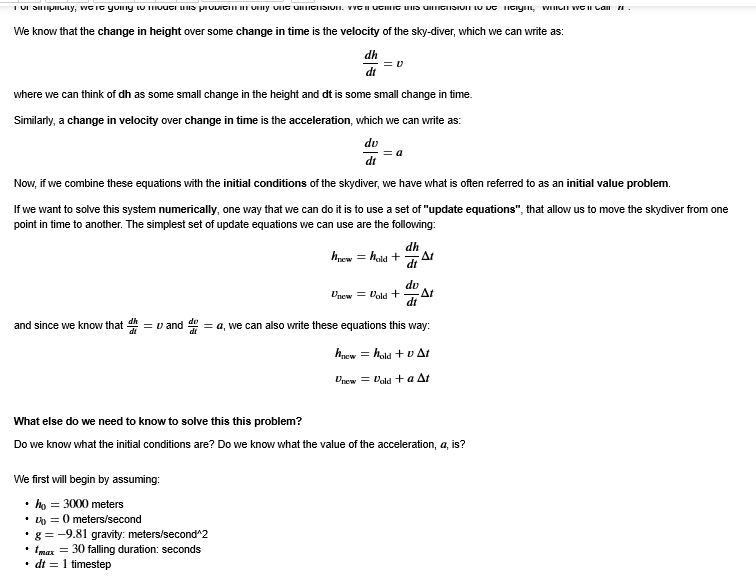Question
PYTHON # Initialize variables h = 3000 # initial height: m v = 0 # initial velocoty: m/s g = -9.81 # gravity: m/s^2 t
PYTHON

# Initialize variables h = 3000 # initial height: m v = 0 # initial velocoty: m/s g = -9.81 # gravity: m/s^2 t = 0 # initial time tmax = 30 # Falling time dt = 1 # timestep
# Initialize lists for storing data height = [] velocity = [] time = []
# Append initial values to lists height.append(h) velocity.append(v) time.append(t)
# Create a function to compute derivaives of velocity and height def derivs(v,g): # derivative of height is velocity dhdt = v # derivative of velocity is acceleration (gravity in this e.g.) dvdt = g return dhdt, dvdt
# Create a time loop that will update the skydiver over time # Use a while loop that will loop until t > tmax while t
plt.figure(2) plt.plot(time, velocity, color = 'purple') plt.xlabel('Time [seconds]') plt.ylabel('Veloctiy [meters/second]') plt.grid()
Adding air resistance to the model
As we can see from our plots above, without air resistance the skydiver continously accelerates under the force of gravity. If they start high enough, they could reach very high velocities! In reality, we know that this isn't how skydiving works, eventually the skydiver reaches what we call terminal velocity, which is the point at which the acceleration due to gravity is balanced by the acceleration due to air resistance, or drag, which opposes the motion of the skydiver.
The acceleration due to friction with the air acts to slow down skydiver and is dependent on the skydiver's velocity. It is defined to be:
air=0.65 ||aair=0.65 A v |v|m
In this equation, A is the projected area of the skydiver, |||v| is the absolute value of the velocity, and the m is the mass of skydiver. When computing the total acceleration of the skydiver, we need to combine both the acceleration due to gravity and the acceleration due to air resistance. That makes the total acceleration:
total=gravity+airatotal=agravity+aair
As before, you are going to model the free-fall of the sky-diver for a total of 30 seconds, but now you need to take into account air resistance. You can assume that the projected area of the skydiver is 0.4 m22 and their mass is 80 kg. Also assume that the skydiver is jumping out of a helicopter at an initial height of 2000 m and use a new timestep size of 0.1 seconds.
Ideally, you should find that eventually the skydiver approaches a constant velocity when the acceleration due to gravity is matched by the acceleration due to friction.
Modify the above code (don't write new code from scratch!) to account for air resistance in the model while using the provided area of the skydiver and the new initial height. Make sure that your new plots make sense. You should see that the velocity flattens out to a constant value, the terminal velocity. If you can, create a list to store the acceleration and make a plot of that as well.
Thank you in advance for your help!
TUI SUTEIL, WCIC Youny LU THUCIUS PIUMICITI HT UITY ULIC UNICUISIUI. VYCH UCIIIC IS INICISIVIILU VE TICIYIL, WHILII WCII Lan . We know that the change in height over some change in time is the velocity of the sky-diver, which we can write as: where we can think of dh as some small change in the height and dt is some small change in time. Similarly, a change in velocity over change in time is the acceleration, which we can write as: Now, if we combine these equations with the initial conditions of the skydiver, we have what is often referred to as an initial value problem. If we want to solve this system numerically, one way that we can do it is to use a set of "update equations", that allow us to move the skydiver from one point in time to another. The simplest set of update equations we can use are the following: dh Haew = haid Unew = Void + 41 and since we know that = v and = a, we can also write these equations this way hrew = hold + v At Drew = Vold + a At What else do we need to know to solve this this problem? Do we know what the initial conditions are? Do we know what the value of the acceleration, a, is? We first will begin by assuming: ho = 3000 meters Un0 meters/second . g=-9.81 gravity: meters/second^2 Imax = 30 falling duration: seconds . dt = 1 timestepStep by Step Solution
There are 3 Steps involved in it
Step: 1

Get Instant Access to Expert-Tailored Solutions
See step-by-step solutions with expert insights and AI powered tools for academic success
Step: 2

Step: 3

Ace Your Homework with AI
Get the answers you need in no time with our AI-driven, step-by-step assistance
Get Started


